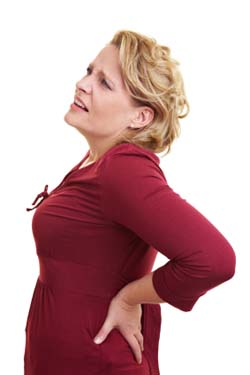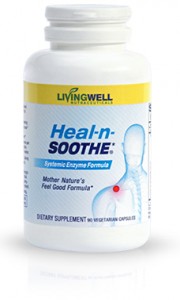If you’ve seemingly “tried everything” but still fight unrelenting back pain, there’s a good chance internal scar tissue could be the culprit.
That’s because depositing scar tissue is part of your body’s natural healing process to recover from injury.
Yet scar tissue can lead to restriction in mobility and build up to place painful pressure on nerves. Drugs may dull the pain but they won’t remove the scar tissue. And healing from surgery itself forms more scar tissue.
In fact, scar tissue may be the leading cause of failed back surgeries.
Even if you’ve never been under the knife, scar tissue may be causing your chronic back pain. The good news is you CAN do something about scar tissue buildup. Safely, naturally and without a doctor’s appointment!
How Scar Tissue Forms
Whenever your body senses an injury or infection, your immune system responds by flooding the area with white blood cells to break down and devour any foreign invaders while prostaglandins kick off the repair process by signaling your body to begin an acute (short-term) inflammatory process.
During inflammation you experience the typical symptoms of redness, heat, swelling and yes, pain. That’s normal. During this restoration process, your body uses a protein called fibrin to repair damaged tissue.
That’s normal.
What’s not normal is when your body fails to shut down the inflammatory process post-healing. That’s when you fall into a damaging pattern of chronic inflammation.
Among other side effects of chronic inflammation, your body continues to deposit fibrin in the inflamed area. This leads to a buildup of scar tissue, causing pain in two key ways.
Why Scar Tissue Causes Back Pain
Fibrin is used to repair broken blood vessels (this is what forms blood clots to stop bleeding) and other damage.
Chronic inflammation allows your body to continue depositing layers of fibrin into an area. Excess fibrin can restrict blood flow, decrease organ function and predispose you to autoimmunity issues. The effects of chronic inflammation are a major cause of cardiovascular disease.
When it comes to back pain, scar tissue typically contributes in two ways:
Adhesions
Excess scar tissue formed by fibrin can cause adhesions of tissues and ligaments to each other. This restriction can cause pain during movement as the adhesions pull apart. Over time, these adhesions can result in significant lost mobility.
Nerve Pressure
When scar tissue presses on a nerve, or causes irritation to a nerve due to nearby adhesions, you’re going to have pain or other negative effects (some nerves don’t relay pain but affect other internal bodily functions – killing you softly without your knowledge).
Any injury or infection can trigger an inflammatory healing process. The extent of injury and how quickly your body ends inflammation following recovery plays a major role in determining how much fibrous scar tissue is deposited.
Once scar tissue has developed, pain pills may temporarily dull the pain but they won’t remove the scar tissue. The key to lasting back pain relief in this circumstance is removing the excess scar tissue.
How to Safely Dissolve Excess Scar Tissue
Even if you’ve never had back surgery, you may already have scar tissue buildup near your spinal column leading to back and sciatica pain. And you should recognize that even “minimally invasive” surgery is still invasive – and will always leave some amount of scar tissue behind.
That’s what one of our customers, Dave Nunley, experienced after two lower back surgeries. Dave told us how the surgeries left two golf ball-sized lumps of scar tissue behind… leaving him with severe sciatica pain. (Read Dave’s story here.)
Amazingly, even though it was his previous back surgery that led to his painful scar tissue adhesions and nerve pressure in the first place, Dave’s doctors only recommended more back surgery to eliminate the problem!
Fortunately, Dave discovered the power of proteolytic enzymes.
Proteolytic enzymes, also called proteases, are naturally produced in our bodies in the pancreas and can be found in smaller amounts in certain foods like pineapple and papaya.
While these enzymes help break down protein during the digestive process, they are instead absorbed into the bloodstream from the small intestine when no proteins are in the stomach to be digested. That’s when the enzymes become systemic, meaning they travel throughout your body to serve as powerful tools to “turn off” the prostaglandins causing inflammation, dissolve excess fibrin and help your body remove toxins and wastes – boosting your immune system.
In short, they help stop the fibrin buildup and help reverse the damage of excess scar tissue.
One key reason many of us experience more pain and slower healing as we age is because the pancreas stops making proteolytic enzymes in abundance starting around our late 20s. A sprained ankle that might have hurt for an hour as a child may take a week to get over in our 40s. And scar tissue allowed to build up after otherwise insignificant injuries may lead to lasting pain and restriction.
Fortunately, there is an easy solution. Supplement with proteolytic enzymes on an empty stomach (so they are absorbed to become systemic and dissolve excess scar tissue). Proteolytic enzymes are among the safest supplements on earth with no maximum amount you can take unlike virtually every drug and many vitamins and other supplements.
Beat Scar Tissue Pain And Chronic Inflammation At the Same Time
When Dave started taking Heal-n-Soothe®, the world’s most powerful natural anti-inflammatory and proteolytic enzyme supplement, he actually took it because it helped relieve nausea and stomach pain from the pain medications he was taking for his sciatica.
But a few months later, he suddenly realized he could no longer feel the golf ball-sized masses of scar tissue on his back. He wasn’t suffering in pain like he had. And he could walk again.
The scar tissue had simply dissolved – safely and naturally – thanks to the proteolytic enzymes he had been taking.
Our customers are not alone. We share the power of proteolytic enzymes everywhere we go – and our own families benefit, too. Healthy Back Institute® co-founder Steve Hefferon’s wife used enzymes to clear up uterine fibroids.
And my own mother swears by them, using enzymes to boost her immune system and clear up itchy hives on her fingers.
Of course, there’s more to the Heal-n-Soothe® formula than the world’s most potent proteolytic enzyme supplement. It’s packed full of a dozen of Mother Nature’s most powerful anti-inflammatories, helping ensure chronic inflammation doesn’t lay down more binding scar tissue simply by taking a few capsules a day.
So if you have unexplained back pain, or any pain at all, I highly recommend trying our Heal-n-Soothe® proteolytic enzyme and natural anti-inflammatory supplement.
Try Heal-n-Soothe® Today!
References
Nathan C. Points of control in inflammation. Nature. 2002 Dec 19-26;420(6917):846-52.
Ricciotti E, FitzGerald GA. Prostaglandins and inflammation. Arteriosclerosis, Thrombosis, and Vascular Biology. 2011 May;31(5):986-1000.





Are the studies on this product?
The studies cited in this article and for this article are not based on this product.
Thanks
Steve